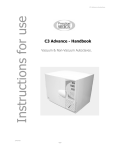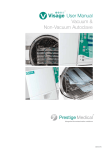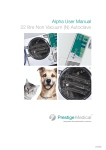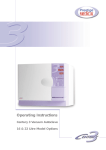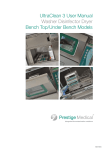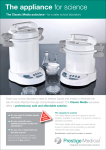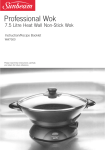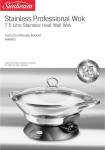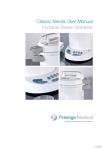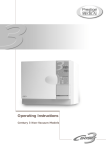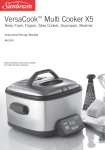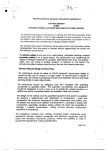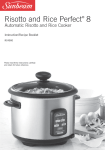Download Advance User Manual Vacuum (B) & Non
Transcript
Advance User Manual Vacuum (B) & Non-Vacuum (N) Autoclaves 304278B 2 Instructions for use Please read these instructions before using the autoclave. Keep these “Instructions for use” in a safe place close by the unit for future reference. Service Helpline: Telephone: 01254 844 116 (UK only - 24hr) e.mail: [email protected] Prestige Medical Service staff are available to provide advice and assistance during normal office hours. To avoid delays when making contact please have the units Model and Serial Numbers at hand. These can be found on the rating plate located at the rear of the unit or on the bezel inside the door. For additional information visit www.prestigemedical.co.uk UK Customers Prestige Medical Limited East House, Duttons Way, Shadsworth Business Park, Blackburn BB1 2QR Tel : +44 (0) 1254 682 622 Fax : +44 (0) 1254 682 606 Overseas Customers Contact your local Contents. Section Page 1Introduction 3 2 4 Operating Symbols, Displays and Controls 3Operation 6 4 Essential Information 9 5 Routine Care and Maintenance 10 6 Trouble Shooting 11 7 Recovery Sequences 12 8 Additional Information 13 9Warranty 14 10 14 Printer and data logger Instructions 11Specification 15 12 Cycle Profiles 16 13 Water Quality 19 14 Loading the Autoclave 19 15 Daily Record Sheet 20 distributor. In case of doubt contact Prestige Medical. www.prestigemedical.co.uk [email protected] Destination Kit Date of purchase Model no. Vessel rating plate (duplicate) 0086 Serial no. Prestige Medical Limited East House, Duttons Way, Shadsworth Business Park, Blackburn BB1 2QR Tel : +44 (0) 1254 682 622 Fax : +44 (0) 1254 682 606 www.prestigemedical.co.uk [email protected] 304278B Registered in England Reg No. 2826793 3 Section 1: Introduction Thank you for choosing the Prestige Medical Advance Autoclave. This machine is fitted with sophisticated control software and will automatically adjust the cycle time dependent on the mass of load used. This will ensure the optimum sterilizing and drying conditions for all loads. All “Type B” vacuum cycles use the triple pulse fractionated vacuum system. Non-vacuum cycles use the thermodynamic air displacement system. Vacuum Drying cycles employ a “closed door” system. Non-vacuum machines employ an “open door” system. An “Auto-cycle start” option is included which allows the user to programme the time of day at which the selected cycle should start. Before unpacking, refer to the “Manual Handling” section on page 13, section 8. Whilst unpacking check the unit for transit damage. If damage is found, please report this to the shipping agent immediately, in writing, and then notify your dealer. Product contents comprise of the following: • Autoclave with internal furniture. • Instructions for Use and warranty card. • Performance Test Certificate and Certificate of Conformance for pressure vessel (all UK models). • Installation sheet. • Written Scheme of Examination (UK models). • Waste water container. • Printer or Data Logger (if applicable). Type B units will also contain a Bowie Dick Test Pack . All Customers, when you receive your Advance autoclave ensure that you complete and return your Warranty Registration Card. Types of load and loading. Advance autoclaves are designed to sterilize instruments, utensils and other items as defined by the European Standard EN13060. Only the vacuum models can effectively sterilize wrapped or pouched instruments and hollow loads. The autoclaves operate automatically with 134°C and 121°C sterilizing temperatures (with or without drying). For a full list of sterilizing cycles and times refer to Section 12. WARNING! Refer to the instrument manufacturer to ensure the instruments suitability for autoclaving and the maximum temperature they can withstand. A “responsible person” must qualify other loads as suitable. Refer to “Additional Information” in Section 8. Refer to “Technical Specifications”, Section 11, for the maximum instrument load for the autoclave. All instruments must be cleaned appropriately prior to sterilizing. Wrapped or pouched loads should not touch adjacent loads. Pouches must be used for one item only. When placing items on a tray or pouch tray, ensure they are placed on the raised ribs (to aid drainage), that they do not touch each other and that the load does not touch other trays or the chamber in any way. Always use the lifting device when removing trays or pouch trays from the autoclave as they may be hot. Long trays should be supported at their rear as they become free of the tray carrier. Pouched instruments should be placed on pouch trays for best drying results Do not use an unprotected hand to hold hot trays. 304278B 4 Section 2: Operating symbols, displays and controls The following descriptions refer to the symbols, controls and displays used on the ADVANCE range of autoclaves. IMPORTANT: Read Operating Instructions before use. Fill water tank when LED illuminated (Maximum fill level is S3 opposite). Hot parts. Do Not Touch. Do not use tap water (S2 below). For acceptable water quality refer to Section 13. Symbols: S1 Cycle status graphic segments. General controls / Operations: Note: The function is selected when the LED adjacent to the button is illuminated. A Standby / Ready button. B Cycle start button. C Door open button. D Select time/date/cycle counter. E Adjust time/date settings (E1/E2) F Select vacuum cycles. G Select Non-vacuum cycles. L H Select “Additional drying”. I Fuses (located behind access panel). J Printer socket A K Main door (not shown) L Fresh water tank drain. L1 M Water fill. D O N Air filter. I O Rating plate. L2 E1 J E2 S2 L3 M N F L6 G S3 S1 L4 L5 H B C 304278B L7 L8 5 Cycle controls vacuum models. Press F to select the vacuum cycles these are as follows: 134ºC /3½ min. Vacuum cycle for porous loads, wrapped, pouched, solid / hollow instruments with drying. 134ºC /18 min. Vacuum cycle for porous loads, wrapped, pouched, solid / hollow instruments with drying. Examples below show:Press H to select “Additional Drying Additional drying. AFTER EVERY CYCLE THE UNIT RETURNS TO THE DEFAULT CYCLE. 134ºC /3½min. Cycle for bagged solid instruments without drying. Additional drying should be added. Default for vacuum units Default for Non-Vacuum units 134ºC /3½ min. Steam penetration test without drying. Suitable for Bowie Dick Test Pack or Helix. Press G to select non-vacuum cycles. 121ºC /15½min. Non-vacuum cycle for unwrapped solid instruments, without drying. Display Options. (Figures shown are for a vacuum unit) 134ºC /3½min. Non-vacuum cycle for unwrapped solid instruments, without drying. L1 Display for “Time” “Date” & “Cycle counter”. L1 (Vacuum units only) The normal display mode is time. The date or cycle counter can be selected L2 by pressing the button D adjacent to the display. The selection is valid until a cycle is completed or until the unit is returned to L3 standby mode, at which point the display will revert to the current time. Cycle controls non-vacuum models. Non-vacuum cycle for unwrapped solid instruments, without drying. L2 Display for “Temperature” Non-vacuum cycle for unwrapped solid instruments, with drying. The 121°C or 134°C led will be illuminated to show which cycle is selected. L3 Display for “Pressure”. The following show the cycle status: (Vacuum unit) L4 Cycle started. L6 L4 L5 L5 Heating and air bleed. L7 L8 L6 Sterilizing. L7 Depressurisation / drying. L8 Cycle complete. 134°C. Non-vacuum cycle without drying. 134°C. Non-vacuum cycle with drying. 304278B 6 Section 3: Operation Please take time to read these instructions before using the autoclave. It is essential that the operator is correctly trained and a “Responsible Person” has been assigned for the management of the autoclave. By following these simple step-by-step instructions you can ensure your instruments are correctly sterilized every time. 1. Installation. Ensure the unit is placed on a strong, flat, level & heat resistant surface. To check if the unit is level, pour half a cup of water into the chamber. The water should flow towards the hole at the rear of the chamber, not out of the front. WARNING! The autoclave is heavy; at least two people will be needed to lift it. Note: Before using for the first time, and after emptying, always add cold (tap) water until the level reaches the minimum level mark. The waste water container can be located in any convenient place provided it is at a lower height than the autoclave, although care should be taken that it cannot be knocked over. WARNING! Waste water and steam condensing coil may be hot. Care should betaken at all times. 4. Setting date and time. Date and time are set in the following sequence. Note: This unit uses a 24 hour clock. Year (tens): Year (hundreds): Month: Day: Minutes: Hours. • Set the autoclave in “Ready Mode” by pressing ready button (A). The LED next to button (A) will then go out. 2. Connection. Plug the unit into the mains outlet socket of the correct type & rating. See rating plate (O). Push the on/off switch on the front of the unit. • Press and hold button (D) for 5 seconds. After a few seconds the LED next to button (A) illuminates and the internal heater operates to control the internal temperature at a set value. • Set year (hundreds); Month; Day; Minutes; hours; by pressing button (D) up and (E1) down. Press button (E2) to accept for each. WARNING! The mains outlet MUST BE EARTHED (GROUNDED). The mains plug should always be easily accessible as it is to be relied upon as “the means of disconnection”. 3. Single use water system. This unit has a “single use” water system designed to prevent the recycling of any contaminants, which may be present on the instruments being sterilized. Ensure the “waste water container” is checked regularly to prevent overflowing. The container should be emptied when the waste water level reaches the “Max” line. To empty the container, undo the screw cap and carefully remove the steam-condensing coil, which passes through the cap.Place on a heat resistant surface whilst emptying the container. Use the carry handle to support the container when emptying. Replace the steam-condensing coil and cap; ensuring it is screwed on securely. 304278B • Set year (tens) by pressing button (D) up and (E1) down. Press button (E2) to accept. • The unit returns to “Ready Mode” when the hours are accepted. 5. Ready. Press button (A) to set the autoclave into “Ready Mode”. The LED next to button (A) will go out. Note: When in “Ready Mode”, the boiler and chamber are kept warm. 6. Water fill – DO NOT USE TAP WATER. Before using the autoclave for the first time fill with water. Press button (C) to open the door. Pour water into the fill spout (M) until it reaches the “Maximum line” (S3). Do not overfill. The water capacity is 3·7 litres. When the low water indicator illuminates, top up with water. Always use de-ionised, distilled or sterile water as recommended (see page 19). NEVER USE TAP WATER. THIS WILL INVALIDATE THE WARRANTY. 7 7. Loading. 134ºC /3½min. Cycle for bagged solid instruments, without drying. Additional drying should be added. Refer to “Loading the Autoclave” at Section 14, page 19 and “Specifications” on page 15 for the maximum permissible load. 134ºC /3½min. Steam penetration test without drying. Suitable for Bowie Dick Test Pack or Helix. Failure to follow instructions may cause the unit to malfunction and result in an unsuccessful cycle Before loading, ensure instruments are cleaned and rinsed thoroughly. Press G to select non-vacuum cycles. 121ºC /15½min. Non-vacuum cycle for unwrapped solid instruments, without drying. Always use the instrument trays or racks, which are supplied or are available as recommended accessories through your supplier 134ºC /3½min. Non-vacuum cycle for unwrapped solid instruments, without drying. Load instruments so that they do not touch other instruments or the chamber and are resting on the ribs of the tray. On non-vacuum units pressing G allows you to scroll round all the 121°C. and 134°C. cycles. Non-vacuum cycle for unwrapped solid instruments, with drying. Either 121°C /15½min. or 134°/3½min. Non-vacuum cycle for unwrapped solid instruments, without drying. Either 121°C /15½min. or 134°/3½min. Only one item should be placed in a pouch. Pouches should be placed in the pouch rack, which replaces the tray. Refer to loading (page 19). Linen loads should be formed into a rectangular pack of size 110mm.x 110mm. x 50mm. (maximum), weighing no more than 1 kg. Place on a pouch tray in the middle of the chamber. Linen loads should not be sterilized in combination with other loads. Press H to select “Additional Drying”. Additional drying. This option can be added before or after a cycle. NB. Additional drying is inactive for the Steam Penetration Test cycle (TP). Drying on this cycle can only be obtained after the cycle has ended by selecting additional drying as described below in (ii). 8. Door closing. (i) To select before starting a cycle: Once the trays are in place, close the door by pushing until a “click” is heard. The LED next to the door open button (C) will then flash for a period of 20 seconds during which time entry in to the unit is restricted. This ‘dwell’ period is used to ensure correct pressure sensing readings are made prior to a cycle being initiated. Access to the unit can be made once this period is complete. (i) Press button (H) once. L4 illuminates to indicate 5 additional minutes. (ii) Press (H) a second time. L4 & L5 illuminate to indicate 10 additional minutes. (iii) Press (H) a third time. L4 L5 & L6 illuminate to indicate 15 additional minutes. (iv) Press (H) a fourth time. This cancels additional drying. (v) Select, then start the required cycle. See “10”. 9. Cycle options. After each cycle the unit will return to the default cycle. On Vacuum units this is the 134ºC /3½min Vacuum cycle for porous loads, wrapped, pouched, solid / hollow instruments with drying (B cycle). Cycle options available on the vacuum autoclave are: (ii) To select after a cycle has been completed: (i) With the door closed press and hold button (H) for 10seconds. L7 flashes to indicate 5 minute drying in progress. (ii) Press button (H) once. L4 illuminates to indicate 5 additional minutes. Now press and hold button (H) for 10seconds. L4 and L5 are illuminated. Then L7 flashes to indicate 10minute drying in progress. (iii) Press button (H) twice. L4 & L5 illuminated to indicate 10 additional minutes. Now press and hold button (H) for 10seconds. L4 L5 and L6 are illuminated. L7 now flashes to indicate 15minute drying in progress. 304278B Press F to select the vacuum cycles these are: 134ºC /3½min. Vacuum cycle for porous loads, wrapped, pouched, solid / hollow instruments with drying. 134ºC /18min. Vacuum cycle for porous loads, wrapped, pouched, solid / hollow instruments with drying. 8 10. Start cycle. Press button (B) to start a fully automatic cycle. A visual display shows the stages of the cycle: Stage 1 Stage 2 Stage 3 Stage 4 Stage 5 Cycle started (L4) Heating and air bleed (L5) Sterilizing (L6) Depressurisation / drying (L7) Cycle completed (L8) During the test, the segments of the cycle status graphic (S1) will flash. The test will take between 15 to 30 minutes. On completion the print-out will advise if the unit has passed or failed the test. If a fail occurs clean the gasket and the chamber rim before repeating the test. If the unit repeatedly fails contact Prestige Medical or your supplier. 11. Opening door. To return to normal use press button A, then button C. At the end of a cycle a buzzer sounds 3 times. Press button (C) to open the door, allowing access to the load. Auto-cycle start. Additional operations. Steam Penetration Test. On vacuum units the “Steam penetration test” should be performed on a daily basis to confirm that the unit is operating correctly. A Prestige Medical Bowie Dick Test Pack or an Albert Browne Test Helix MUST be used with this test. The Pack or Helix should be placed on an instrument tray in the middle of the chamber towards the front. The unit can be programmed to enable any cycle to be started at any time of the day when the unit is unattended. This option is recommended particularly when the operator performs “Air leak detection test”. • Set the autoclave in “Standby Mode” by pressing ready button (A). The LED next to button (A) will illuminate. • Press and hold button (D) for 6 seconds and release. The time display (L1) will flash with the default time of 06.30 being displayed. • Press (E2) to accept. If another time is required for the auto-cycle start, change minutes then hours; by pressing button (D) up and (E1) down. Accept by pressing button (E2). • The unit returns to “Ready Mode” and the LED to the left of the clock symbol continues to flash. Albert Brown Test Helix Run the cycle Bowie Dick Test Pack for the steam penetration test. Following this test, the Test Pack or Helix TST should change to a uniform purple colour. If the TST is not a uniform purple colour check the door gasket and vessel. Repeat the test. If the test fails again seek technical assistance. Vacuum system leak test. The “vacuum system leak test” checks the integrity of the vacuum system. NB. A printer or data logger MUST be fitted. The test MUST be undertaken when the unit is cold and dry (before any other cycle has been run). Set the autoclave in “Standby Mode” by pressing ready button (A). The LED next to button (A) will illuminate. Press and hold button (F) for 6 seconds. The display (L1) will begin to count down. Hold button (F) until the count down reaches zero. The test will then start. 304278B • Select the required sterilizing cycle using buttons (F), (G) and (H). • Load the instruments in the chamber and close the door. • Press the start button (B). The door LED (C) and the start LED (B) both flash. The clock symbol LED is still flashing. • The selected cycle will start when the programmed start time is reached. The clock symbol LED flashes until the cycle is completed. • To abort a timed cycle (before the cycle starts) press the “Standby button” (A). 9 Section 4: Essential information To ensure that the autoclave continues to operate correctly, it is important to adhere to the following points and to carry out the necessary care and maintenance procedures as specified. This product is not a washing / cleaning machine. Do ensure that..… … you read and follow these Instructions for Use. … the load is suitable for sterilizing and the cycle selected. … the load can be sterilized at the selected temperature. … the load has been cleaned. … the load has been rinsed thoroughly in clean water prior to sterilization to avoid any chemical residues left after cleaning contaminating the autoclave. … when placing instruments on trays, ensure that they are placed on the ribs of the tray (to help drainage), they must not touch each other and must not interfere with other trays or the chamber above. … only distilled, de-ionised or sterile water is used (as recommended on page 19). … the autoclave is in a draught free area. … the autoclave is not installed in an enclosed cupboard space. Disposal WEEE Statement (Waste, Electrical and Electronic Equipment) The WEEE directive places an obligation on all EU-based manufacturers and importers to take-back electronic products at the end of their useful life. Prestige Medical Limited accepts its responsibility to finance the cost of treatment of redundant WEEE in accordance with the specific recycling requirements. The symbol (shown below) is present on all Prestige Medical products, which indicates that the product must NOT be disposed of with other waste. Instead it is the user’s responsibility to dispose of their waste electrical and electronic equipment by handing it over to an approved reprocessor, or by returning it to Prestige Medical for reprocessing. For more information about where you can send your waste equipment for recycling, please contact your local city office or Prestige Medical. … the door is left ajar when not in use. … you quote model/serial number (which are located on the lower left hand side of the front bezel, behind the door moulding and also on the rear case just above the mains power cord entry) and date of purchase in all correspondence. … only qualified personnel regularly service the autoclave. It is recommended that a Chemical Indicator strip be used every cycle to verify that the sterilizing cycle is effective. If the Chemical Indicator strip fails to change colour repeat the cycle. If it still fails to change colour then arrange for a service. Do not…. … lose this handbook. … add any chemicals whatsoever to the water. … attempt to sterilize volatile substances, toxic materials or other unsuitable loads. (Refer to your “Responsible Person” for advice) … place the autoclave in direct sunlight. … place the autoclave on heat sensitive surfaces. … use inappropriate cleaning materials. … drop or abuse the autoclave. … use in areas of risk associated with flammable materials or gases. … remove the casing or attempt to service or repair the autoclave. 304278B 10 Section 5: Routine care and maintenance WARNING! Disconnect the autoclave from the mains power supply before cleaning. DAILY MAINTENANCE Gasket THE GASKET MUST BE CLEANED ON A DAILY BASIS, BEFORE USING THE AUTOCLAVE. Wipe exposed surface of the gasket and the surface of the vessel with warm soapy water using a lint free damp cloth. Wipe both the gasket and the vessel again with water using a lint free damp cloth to remove any residual soap. Routine maintenance. Annually replace the water filters. Gasket replacement Should the gasket develop a persistent leak it should be removed, cleaned thoroughly in warm soapy water and shaken dry. Wiping with a lint-free cloth is acceptable (Other materials may lead to contamination of the gasket with fibres). The door gasket plate must also be cleaned. If the leak persists you should obtain and fit a new gasket. To remove the gasket, undo the two thumb-nuts (309070) in the centre of the gasket plate. Thumb-Nuts EVERY 250 CYCLES. Clean the autoclave using Autoclave cleaning kit (Part No. 289138). Sealing Lip - ensure the gasket is orientated correctly WARNING Failure to perform these procedures may result in the unit (Part No. 289138). showing UOD1 on the display (UOD1 indicates that the unit may have been contaminated and could fail to operate correctly). EVERY 500 CYCLES. Change the air filter situated at the front of the autoclave. Gently unscrew the filter, and fit the replacement. Entry port plug Remove the plate/gasket assembly and then remove the gasket from the plate. CAUTION: Ensure the gasket is located the right way around on the plate, the lip should face outwards. During re-assembly, place new black sealing washers (supplied with the gasket) in the machined recesses in the door casting. Exterior surfaces (as required). Exterior surfaces should be cleaned with warm soapy water using a damp cloth. For persistent marks, use a gentle cream cleaner. Fresh water tank / Waste water container. On a monthly basis, fully drain the water tank and leave overnight (use Autoclave cleaning kit Part No. 289138). Drain, then refill with fresh water. Repeat this operation twice more to remove any residue. Always use de-ionised, distilled or sterile water as recommended. NEVER USE TAP WATER. Ensure that the entry port plug aligns with the hole in the cast lid. Prior to tightening the two thumb-nuts ensure that the gasket is correctly seated on the gasket plate and in the door recess. DO NOT over-tighten the thumb-nuts as this may damage the thread. 304278B 11 Section 6: Trouble shooting If the machine does not complete a sterilizing cycle, a visual and audible indication will be given. The reason can then be determined by reference to the guide below. The recovery sequence allows access to any instruments within the autoclave and is the first step when rectifying the condition. In the unlikely event that a cycle fails to complete, instruments should be reprocessed as they may not be sterile. User Message Cause Remedy. UOD1 and UOD2 Unit contamination or gasket wear. Conduct routine maintenance procedures. Replace gasket. If the condition persists an engineer call-out may be required. Low water LED (E2) Insufficient water to run a cycle. Press button (A) twice. Top up with water to mark (S3). “door” illuminates on display (L2) Cycle start button pressed whilst door is open or door micro-switch requires adjustment. If door closed but door LED (C) not illuminated - push on door to see if LED can be illuminated. If door open, close door and try again. If fault occurs during a cycle – follow Recovery sequence “i” 01 Power failure during a cycle or power to Recovery sequence “i” unit switched off prior to cycle completion. Check power supply – repeat the cycle. b02 Sterilizing Temperature out of range. Contamination of Sensors. Contamination or wear of the gasket. Recovery sequence “i”. Clean gasket and chamber face then repeat the cycle. If fault persists engineer call-out may be required. d02 Probe temperature difference out of range. Recovery sequence “i”. Conduct routine maintenance procedures. Clean gasket and chamber face then repeat the cycle. If fault persists engineer call-out may be required. t02 Clock error. Recovery sequence “i”. Check & rest the clock – repeat the cycle. If fault persists engineer call-out required. p02 Sterilizing Pressure out of range. Recovery sequence “i”. Clean gasket and chamber face then repeat the cycle. If fault persists engineer call-out required. 03 Air bleed has not been successful. Recovery sequence “i”. Clean gasket and chamber face then repeat the cycle. 04 Vacuum failure. Recovery sequence “i”. Clean gasket and chamber face then repeat the cycle. 07 Sensor fault – Boiler thermistor. Recovery Sequence “ii” – Repeat cycle. If fault persists engineer call-out may be required. 08 Sensor fault – Pressure transducer. Recovery Sequence “ii” – Repeat cycle. If fault persists engineer call-out may be required. 10 Water in the boiler. Recovery Sequence “iii” – Repeat cycle. 13 Water fill time out. Recovery sequence “i”. Drain water out of the fresh water tank and refill with de-ionised, distilled or sterile water. Repeat the cycle. 14 Sensor fault – Chamber probe. Recovery Sequence “ii” – Repeat cycle. If fault persists engineer call-out may be required. 15 System Leak. Recovery Sequence “ii” – Clean gasket and chamber face then repeat the cycle. If fault persists engineer call-out may be required. 16 Low Induced leak rate (NHS ONLY) Seek advice from Responsible person. UOD3 Vacuum failure in drying stage. Contamination or wear of the gasket. Recovery sequence “i”. Clean or change gasket. If fault persists Engineer call-out required. As non-warranty related calls can be expensive it is advisable to ensure that all consumable items have been replaced or cleaned as appropriate, and that the water quality is as described in Section 13 before contacting Prestige Medical Ltd. For Engineer Assistance Call the Service Help line +44 (0) 1254 - 682622 (24hr) email: [email protected] 304278B 12 Section 7: Recovery sequence (allows instruments to be removed from the unit). Recovery Sequence (allows instruments to be removed from the unit). Recovery Sequence “i” Recovery Sequence “ii” Recovery Sequence “iii” Press button (A) Stabilize (no flashing or bleeping) Press button (A) Stabilize (no flashing or bleeping) Press button (A) Stabilize (no flashing or bleeping) Service required. NB: Cannot proceed. Switch off at mains supply. Service required. Press button (A) to enter “Ready Mode” Press button (A) “Recover” The Recovery sequence (depending on where the fault occurs) will flush the water from the boiler and eventually complete the cycle with a continuous bleeping to indicate recovery is completed. Important. Before restarting a cycle, check that the mains plug is fully inserted into the mains outlet socket and the outlet is of the earthed/grounded type. Should all power be lost the door cannot be opened until power is restored and pressure returned to ambient. Should an internal power failure occur, the door cannot be opened until: 1. The unit has cooled down to atmospheric pressure. Access can then be made using the supplied tool. 2. A service has been carried out. In the event of failure of an indication device a service will be required to correct the condition. Should a safety feature operate, unplug the unit and call for a service – do not attempt to correct the fault. Primary safety features: Two primary features have been fitted – a pressure release valve and a boiler over temperature safety cut out. IMPORTANT NOTE ON EMERGENCY DOOR OPENING PROCEDURES. If the door interlock lever does not fully release during door opening and the door led has gone out, light pressure on the door will re-illuminate the door open led. It will then be possible to open the door in the normal manner using the door open button. Door opening – Power loss. If the machine has suffered a loss of power and it is essential to open the machine to remove instruments, the following procedure should be followed. This should only be performed by the nominated responsible person: 1. Disconnect the unit from the mains supply. 2. Allow the machine to cool down to room temperature. 3. Remove the protective white protective cap on the top of the machine. 4. Using the hook on the special tool, release any pressure/vacuum inside the vessel by hooking the ring on the pressure relief valve and pulling this towards you. As shown opposite. 5. Insert the straight end of the special tool into the interlock lever release guide hole and push inwards. If the tool starts to buckle at the preformed strain relief repeat from 3 above. See Photograph opposite. DO NOT ATTEMPT TO OPEN THE VESSEL IF PRESSURISED. ONLY USE THE TOOL PROVIDED AND FOLLOW THE INSTRUCTIONS ABOVE TO GAIN ACCESS TO THE MACHINE. 304278B Door release tool hole 13 Section 8: Additional information Operator: Approvals: The person assigned to use the autoclave. Approvals are all model specific. However, the following standards apply in whole or part: Responsible person: The person who is responsible for the management of the equipment, load assignment, care and maintenance. This person is also responsible for ensuring that all applicable Health & Safety Regulations are applied including those relating to the pressure vessel. This person must verify that only suitably qualified persons undertake repair and maintenance work other than that described under “Routine Care and Maintenance” within this handbook. Qualified person: A person who is qualified by training or experience to a recognised level in respect of the work to be undertaken. Service: • • • • • • Medical Devices Directive (MDD 93/42/EEC) Electro Magnetic Compatibility Directive. European Sterilizer Standard (EN13060) Pressure vessel to ASME Section 8. BS EN 61010 Parts 1 and 2 UL/CSA 3101 Spares: Only those spare parts supplied or specified by Prestige Medical should be used in the maintenance of the autoclave. Use of unauthorised parts will invalidate any warranty and may adversely affect the performance or safety of the unit. Accessories / Consumables Manual handling: Printer (Part Nos. Due to the weight of the unit two people are required when unpacking or moving the product. Data Logger 279565 Optional and can be fitted by the user. UNPACKING. When lifting the unit out of the box ensure there is one person on either side of the unit. Lift out of the box and place on the work surface. Printer roll (Part No.279505): Ten replacement rolls. Calibration and maintenance as required. POSITIONING. Start lifting by holding the unit below the front bezel (large plastic moulding). As clearance is gained, lift at the other corners. Place in position, and release in the reverse order to lifting. NOTE Always drain the water tank before moving. Before moving always allow 30 minutes after use for the unit to cool down. Cleaning materials: Mild washing up liquid. Non-abrasive cream cleaner. Disinfectant diluted in water. Autoclave Cleaning Kit 289138. Product decontamination. Should the unit require repair, it must be decontaminated in accordance with a recognised procedure prior to return or on-site repair. A statement of equipment contamination status must be available with the product. Details of a suitable procedure are available on request from Prestige Medical Ltd. 279519 Europe 279520 UK 279521 Australia): Furniture: 22 litre pouch tray (Part No. 309071). 16 litre Pouch tray (Part No.309066): Tray lifter (Part No.279007): Door tool (Part No.309068): Door plate thumb screw (Part No.279300): Set of 4 gaskets (Part number 279571): “O” Ring door (Part No.279100): Waste Water Container (Part No.279503) Container for single use water. Bowie Dick Test Pack (Part No.309031): Helix Test Pack (Part No. 329001) TST strips (Part No. 259277) Autoclave cleaner (Part No.289138): For cleaning the autoclave to ensure continued operation. Air filter (Part No.273096A): Replacement air filter. 3 Tray Rack (Part No.289132) Set of two 10 instrument clip trays (Part No. 309081) Set of twelve 10 instrument clip trays (Part No. 309082) Set of three 5 instrument clip trays (Part No.276395A) Set of two 3 instrument clip trays (Part No.276396A) 304278B 14 Section 9: Warranty Section 10: Printer instruction Prestige Medical Ltd will, in the first twelve months from the date of purchase (or 18 months from the date of factory despatch – whichever is first), repair or replace free of charge any parts* inclusive of labour which prove to be defective in workmanship and / or materials. Power on procedure In the following twelve months Prestige Medical Ltd will replace free of charge any parts which prove to be defective in workmanship and / or materials exclusive of labour. This warranty cover is dependent on authorised servicing of the unit at least every 12 months and that Prestige Medical Ltd received the warranty card within 3 months of installation. Prestige Medical Ltd will not be liable in the event that the purchaser has failed to adhere to the instructions contained herein or if the autoclave has been abused, interfered with, altered, repaired or serviced by any unauthorised party. This may result in the protection provided by the equipment being impaired. Connect the printer to the power supply and switch on at the mains. The LED light will illuminate on the printer. Connect the printer to the autoclave with the supplied cable. The printer connection at the autoclave is connector J - see page 4 Replacing Paper Roll – Part Number 279505. If the paper roll needs replacing, open the paper cup lid and remove the remaining paper using the button, do not pull paper through the printer mechanism. Reel off a few centimetres from a new roll and check that the end has a clean straight edge. Slide the leading edge of the paper through the paper entry slot, with the leading edge feeding forwards from the bottom of the roll, until you feel resistance. Press the button and feed paper through the paper exit slot. Sit the new paper in the paper cup and close the lid. * This warranty excludes the door gasket, all internal furniture and consumables. Should the paper become creased or out of line when feeding in a new roll, cut the end off the paper roll, feed out the creased paper using the button, and reload ensuring the paper has a clean straight edge. Consumer’s statutory rights are not affected. Status LED. The Prestige Medical Ltd policy is one of continuous development and as such reserves the right to change the specification of the models and items illustrated and described herein at any time. The printer incorporates an LED indicator to report its condition. If there is a fault the LED will flash in sequence. The fault can be identified by counting the number of flashes. LED Indication. Condition Solution. On Printer On - Off Printer Off or Asleep - Paper Out Fit new paper Thermal head too hot Allow head to cool * ** * * ** ** Place the printer on the worktop at the side of the autoclave. Do not place the printer on the top of the autoclave. Make sure the paper is kept away from hot surfaces such as the dump pipe etc. Store the printouts in folders away from direct or indirect sunlight. Data logger instructions Refer to the instructions supplied with the data logger for setting up and operating the data logger. 304278B 15 Section 11: Specification Chamber Capacities 16litre 22litre Overall product width 480mm. 480mm. Overall product height 410mm. 410mm. Overall product length 440mm. 610mm. Unpacked weight 42Kg. (Max) 43Kg. (Max) Chamber Diameter 250mm. 250mm. Chamber lengths 330mm. 430mm. Max. Instrument length 290mm. 420mm. Max. load non-vacuum 6 kg 6 kg Max. load vacuum *Pack size 110x110x50mm. 6 kg (un-pouched) 2 kg (pouched) 1 kg (porous)* 6 kg (un-pouched) 2 kg (pouched) 1 kg (porous)* Sterilizing temp/time. 134ºC/3½mins 134ºC/18mins. 121ºC/15½mins 134ºC/3½mins. 134ºC/18mins. 121ºC/15½mins. Operating pressure (Minimum) 2.05bar (gauge). 2.05bar.(gauge) Voltage/Wattage 230v. /2200W 230v. /2200W Frequency 50 – 60 Hz. 50 – 60 Hz. NB. The overall cycle time will increase as the mains supply voltage decreases. Chamber component materials. Vessel: Boiler: Lid: Door Plate: Stainless Steel – 304 –S15 Aluminium – LM25 Aluminium – ASME SB26 356.0 T6 Stainless Steel – 304 –S15 Fuses: Located at the rear of the unit under the access panel I. O I J WARNING Disconnect the autoclave from the mains power supply before changing fuses. Only qualified personnel should replace fuses. Rating: All products are rated for intermittent use, continuously. Heaters: Cast into the boiler. Internal heater. Temperature cut out: Bi-metallic type rated at 180ºC. with automatic reset. Pressure release valve: Operates at 2.9bar. Accumulation is <10%. Maximum single fault temperature: 143ºC determined by the pressure release valve. Over voltage category: Group II Pollution degree: Group II Insulation: Class I. Environmental conditions: Indoor use at an altitude of up to 2,000m. Ambient temperature range +10ºC to +40ºC Maximum relative humidity 80% for temperatures up to 30ºC, decreasing linearly to 50% at 40ºC. Mains supply voltage range 207 to 254volts. Drying performance maybe affected by local environmental conditions. Safety shutdown: The machine is fitted with an automatic thermal reset mechanism. In the event of the boiler overheating (for example due to accidental overload), the unit will power down. After approx. 10 minutes, power will automatically be restored and the display will show Error 01. The load will need to be re-processed, ie start the cycle again. Storage: When leaving the unit standing idle for any length of time, switch mains off & drain the water tank especially if there is a possibility of the room temperature dropping below freezing point. Packaging: Packing materials used have been selected for ease of recycling. Please ensure you use the correct disposal system for disposal of packing materials. Maximum water usage: Vacuum cycles = 600mls per cycle (typical). Non-Vacuum cycles = 450mls per cycle (typical). Maximum power used: 16litre = 1.18kwh Fuse type: M12A 32x6.3mm. Ceramic sand filled (230v) Mains plug top fuse (user replaceable) F13A to BS1362 UK only. 304278B 16 Section 12: Cycle profiles The profile below is for the 134ºC /3½min vacuum cycle. 22litre = 1.33kwh. LEQ sound level = 60db. The profile for the 134ºC /18min. vacuum cycle differs only in the sterilizing hold time (stage 7 to 8). The 134ºC /3.5 min. steam penetration test is identical to the above profile but without drying (Stage 9 to 10). Programme Step Time min:sec START 00:00 1 00:00 Typical Point 1 1 to 2 02:30 Typical Point 2 300 mbar abs. 2 to 3 06:30 Typical Point 3 2·9 bar abs. 3 to 4 06:00 Typical Point 4 480 mbar abs. 4 to 5 05:00 Typical Point 5 2·90 bar abs. 5 to 6 06:00 Typical Point 6 480 mbar abs. 6 to 7 07:00 Typical 7 to 8 03:30 Fixed 8 to 9 01:30 Typical. 9 to 10 15:00 Fixed. END 304278B 53:00 Typical Temperature (Measured Value) Pressure (Measured Value) Point 7 3.04 bar abs. 134 to 137ºC. 3·04 bar abs. to 3·32 bar abs. Cycle identification. 17 The profile below is for the 134ºC /3½min. cycle for Bagged solid instruments. NB. Additional Drying must be added to this as detailed on page 7. Programme Step Time min:sec START 00:00 Point 1 1 TO 2 02:00 Typical Point 2 300 mbar abs. 2 TO 3 09:00 Typical Point 3 2.9bar abs. 3 TO 4 01:30 Typical Point 4 1.5bar abs. 4 TO 5 02:00 Typical Point 5 3.04bar abs. 5 TO 6 03:30 Fixed. 6 TO 7 02:00 Typical. 7 TO 8 15:00 Fixed END Temperature (Measured Pressure Value) (Measured Value) 134 to 137ºC. Cycle Identification. 3·04 bar abs. to 3·32 bar abs. ADDED DRYING – NOT SHOWN ABOVE. Could also be 05:00 or 10:00 depending on the amount selected. Typical. 35:00 304278B 18 The profile below is for the cycles sterilizing (Stage 3 to 4). Programme Step Time min:sec START 00:00 1 (Non-vacuum cycle on a Vacuum Machine) the only difference being in Temperature (Measured Value) Pressure (Measured Value) Cycle Identification. 00:30 & 00:30 Typical Point 2 750-mbar abs. in both cases. Figures in bold. 2 to 3 11:00 & 11:00 Typical Point 2 3.04 bar abs. & 2.05 bar abs. 3 to 4 03:30 & 15:30 Fixed 4 to 5 02:30 & 03:30 Typical 134·0 to 137·0ºC. 121·0 to 124·0ºC. 3·04 bar abs. to 3·32 bar abs. 2.05 bar abs. to 2.25 bar abs. Figures in RED. END 17:30 & 27:30 Typical On non-vacuum machines the vacuum assisted fill is not present. THE CYCLE PROFILES SHOWN ON THIS AND EARLIER PAGES ARE FOR THE 16 LITRE AUTOCLAVE. 304278B 19 Section 13: Water quality Must be suitable to produce steam in accordance with international standards. Example specification for clean steam Determinant Value Recommended test for compliance Based on sterilized water for Injections BP: Acid or Alkalinity. NQ BP test. Tests for pH are not an acceptable substitute. Ammonium 0.2mg/litre BP test or other suitable method Oxidisable substances. NQ BP test. Calcium and Magnesium. NQ BP test. Tests for hardness are not an acceptable substitute. Heavy Metals. 0.1mg/litre BP test. Tests for individual elements are not an acceptable substitute. Chloride 0.5mg/litre BP test or other suitable method. Nitrate 0.2mg/litre BP test or other suitable method. Sulphate NQ BP test. Residue on evaporation 30mg/litre BP test. Conductivity measurement is not an acceptable substitute. Pyrogens 0.25EU/ml BP test. Phosphate 0.1mg/litre Any suitable method. Silicate. 0.1mg/litre Any suitable method. Based on EN 285: Routine monitoring only: Electrical Conductivity at 25°C 35μS/cm NQ = Not Quantified; BP = British Pharmacopeia; EU = Endotoxin unit. (Consideration should be given to single shot type sterilizers, where water is not returned to the reservoir at the end of the cycle). USE OF WATER OUTSIDE THE ABOVE SPECIFICATION MAY INVALIDATE THE MACHINE WARRANTY. Section 14: Loading the autoclave Loading has a significant impact on how the autoclave performs. Pouches should be arranged so that they do not touch or overlap neighbouring pouches. The maximum permissible loads are as follows: - If using pouch trays, these should be spaced so that there is a good airflow between the trays. 6 kg for Non Vacuum Cycles 6 kg for Vacuum cycles (un-pouched) 2 kg for Vacuum cycles (pouched) 1 kg for Vacuum cycles (porous load) Always use the instrument trays or racks, which are supplied. When loading the trays into the rack use the top rungs of the rack first and work down. Pouches should be placed on pouch trays with the paper side down as shown below. Load instruments so that they do not touch other instruments or the chamber and are resting on the ribs of the tray. Only one item should be placed in a pouch. Pouches may be placed on the Pouch Trays provided (additional trays may be purchased as an optional extra). 304278B 20 Section 15: Daily record sheet - Advance Autoclave If printer fitted, staple print outs to the sheet L OAD TYPE. (See KEY below) CYCLE SELECTED. DATE CYCLE NUMBER PASS OR FAIL * KEY FOR LOAD TYPES: - B = Hollow Instruments P = Pouched or bagged Instruments U = Unwrapped Instruments M = Mixed OPERATOR *If a cycle fails record the Error Code in the Pass/Fail column For Engineer Assistance call the Helpline 01254 844 116 e-mail: [email protected] Always quote your Model details, Serial Number and date of purchase when contacting Prestige Medical or your Supplier. (See page 2 of this manual). 304278B




















